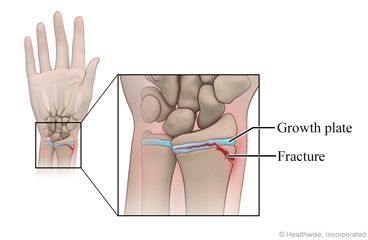Growth Plate Fracture in Children: Care Instructions

Overview
A growth plate fracture is a type of break in a child's long bone, such as a thigh bone. Arms, lower legs, and fingers are other examples of limbs that have long bones.
Growth plates are located at both ends of a long bone. A break that goes through the growth plate can affect the growth of that bone. These type of breaks are common.
Treatment for your child's broken bone will depend on how bad the break is and where it's located. Many broken bones need only splinting or casting. Others may need surgery to realign the bone or keep it in place.
Your doctor may have put the broken bone in a splint or a cast. This will allow it to heal or keep it stable until your child sees another doctor. It may take weeks or months for your child's break to heal. You can help it heal with some care at home.
A sedative may have been given to help your child relax. Your child may be unsteady after having sedation. It takes time (sometimes a few hours) for the medicine's effects to wear off. Common side effects include nausea, vomiting, and feeling sleepy or cranky.
Follow-up care is a key part of your child's treatment and safety. Be sure to make and go to all appointments, and call your doctor or nurse advice line (811 in most provinces and territories) if your child is having problems. It's also a good idea to know your child's test results and keep a list of the medicines your child takes.
How can you care for your child at home?
- Follow your doctor's directions for wearing a cast or splint.
- If your child has a splint, do not take it off unless the doctor tells you to.
- If your child's splint is too tight, ask your doctor if it can be adjusted. Your doctor will show you how to do this and will tell you when you might need to adjust the splint.
- Be safe with medicines. Give pain medicines exactly as directed.
- If your child is not taking a prescription pain medicine, ask the doctor if your child can take an over-the-counter medicine.
- If the doctor gave your child a prescription medicine for pain, give it as prescribed.
- Store your child's prescription pain medicines where no one else can get to them. When you are done using them, dispose of them quickly and safely. Your local pharmacy or hospital may have a drop-off site.
- If possible, prop up the injured limb on a pillow anytime your child sits or lies down during the next 3 days. Try to keep it above the level of your child's heart. This will help reduce swelling.
When should you call for help?

Call 911 anytime you think your child may need emergency care. For example, call if:
- Your child has sudden chest pain and shortness of breath, or your child coughs up blood.
- Your child has trouble breathing. Symptoms may include:
- Using the belly muscles to breathe.
- The chest sinking in or the nostrils flaring when your child struggles to breathe.
- Your child is very sleepy and is hard to wake up.
- Your child passes out (loses consciousness).
Call your doctor or nurse advice line now or seek immediate medical care if:
- Your child has increased or severe pain.
- Your child has problems with the cast or splint. For example:
- The skin under the cast or splint is burning or stinging.
- The cast or splint feels too tight.
- There is a lot of swelling near the cast or splint. (Some swelling is normal.)
- Your child has a new fever.
- There is drainage or a bad smell coming from the cast or splint.
- Your child's skin around the broken bone feels cold or changes colour.
- Your child has symptoms of a blood clot in the arm or leg (called a deep vein thrombosis). These may include:
- Pain in the arm, calf, back of the knee, thigh, or groin.
- Redness and swelling in the arm, leg, or groin.
Watch closely for changes in your child's health, and be sure to contact your doctor or nurse advice line if:
- Your child does not get better as expected.
Where can you learn more?
Go to https://www.healthwise.net/patientEd
Enter D781 in the search box to learn more about "Growth Plate Fracture in Children: Care Instructions".
Current as of: July 31, 2024
